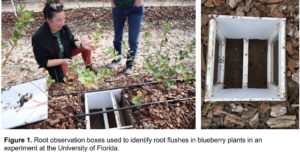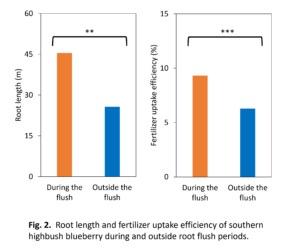Final report for GS22-267
Project Information
Blueberry farms have a high potential for nutrient leaching. Previous research in our lab has identified periods when young roots are abundant (root flushes) in blueberry. In other crops, young roots are more efficient at taking up nutrients than old roots. This project aims to assess nutrient uptake during and outside root flushes to inform fertilizer timing in blueberry. We will use fertilizers with isotopic nitrogen (N15) to measure nutrient uptake efficiency in an experimental field in Citra, FL during three points in the season: spring, fall, and winter dormancy. We will use these data to calculate nutrient uptake efficiency and relate it to root flushes. We will disseminate results from this research using traditional (extension publications) and innovative (extension videos and social media) tools. Altogether, we aim to make blueberry farming more sustainable by identifying periods when growers should fertilize to promote uptake efficiency.
The overall objective of this project is to increase nitrogen uptake efficiency in blueberry farms by improving fertilizer timing. I aim to investigate if nutrient uptake efficiency is higher during periods when young roots are abundant (root flushes). Specific objectives include:
Objective 1: Evaluate nitrogen uptake rates during and outside root flush periods in southern highbush blueberry (SHB).
Activity 1-1: Measure blueberry nitrogen uptake efficiency in SHB plants during three key parts of the year (spring, fall, and winter dormancy).
Objective 2: Disseminate research results to inform growers, citizens, and young adults.
Activity 2-1: Write and publish an extension article focused on fertilizer timing. Current blueberry growers are the intended audience for this article.
Activity 2-2: Record and publish an instructional video focused on blueberry fertilizer timing. Growers and industry professionals are the intended audience for this video.
Activity 2-3: Record and publish series of videos focused on at home blueberry production and the basics of sustainable fertilization practices in social media platforms (Twitter, TikTok, and Instagram). Young adults not familiar with growing blueberries and home gardeners are the intended audience for these media.
Research
Previous research in our lab has identified a large blueberry root flush period in between August and November (Nunez et al. In preparation). Fang et al. (2018) showed that nitrogen uptake rates peak between August and October. The overlap of root flushes and peak nitrogen uptake suggests there is a relationship between the two, which we aim to explore further.
Objective 1: Evaluate nitrogen uptake rates during and outside root flush periods in Southern Highbush Blueberry.
We studied nitrogen uptake rates in 2 southern highbush blueberry varieties, ‘Sentinel’ and ‘Arcadia’ grown at the UF Plant Science Research and Education Unit (lat. 29°24′300″N, long. 82°8′521″W) in Citra, Florida. Plant spacing is 2.5 ft in row with 9.5 ft between rows (1936 plants/acre) in pine bark beds. The soil is classified as Arrendondo sand. Nitrogen-free fertigation was applied through drip tape. To measure nitrogen uptake efficiency, we applied isotopic nitrogen (15N) according to the method outlined by Fang et al. (2018). Isotopes are naturally occurring versions of an atom that can be measured separately due to their different weights. 15N is a stable isotope that represents 0.336% of all nitrogen in the planet (Mariotti, 1983). Due to its safety and stability, 15N is widely used in agricultural and ecological studies.
Treatments consisted of applying 10% 15N labeled ammonium sulfate fertilizer at two points in the season: 1) during the fall root flush and 2) outside of the root flush (in spring). At each treatment application, 8 plants (4 ‘Sentinel’ and 4 ‘Avanti’) were fertilized with 0.57 g 15N/plant, the equivalent of 125 lbs of N/A/year. 15N ammonium sulfate fertilizer was dissolved in water and applied manually. Two weeks after application, plants were destructively harvested by removing the entire plant including roots up to 30 cm deep. Roots were carefully washed to remove soil material while minimizing tissue losses. Plant tissues were separated into root and shoot, measured by weight, and oven dried. Dried tissue was ground and loaded into scintillation vials for testing at the Light Stable Isotope Mass Spectrometry Lab (University of Florida) for total 15N and N. We calculated nutrient uptake efficiency as the ratio of recovered N divided by provided N in each sampling period. We also measured root abundance at each point in the season using root observation boxes and a RBG cameras, which are part of Ms. Goldsby's ongoing MSc. research (Figure 1).

Objective 2: Disseminate research results to inform growers, citizens, and young adults.
To inform farming practices, the research results must reach growers and make an impact on them. Sharing research outcomes at no cost and through diverse media broadens access to the research and increases its potential impact on grower practices.
Ms. Goldsby will write an extension article focused on fertilizer timing using results from this research. Current blueberry growers are the intended audience for this article. Dr. Nunez will co-author this article. the article will be submitted for review before the end of the gran period.
We recorded an instructional video detailing the results of this research. The audience for this video is growers and industry professionals. Professional video recording and editing support was provided by UF IFAS Communications. The video is in the post-production stage now. We expect the video to be published in the next month.
Finally, we will record and publish a series of videos focused on backyard blueberry production and the basics of sustainable fertilization practices. The videos are intended for young adults not familiar with growing blueberries and home gardeners. Videos will be posted on social media platforms (Twitter, Facebook, and Instagram) to reach interested parties by targeting a different demographic than the extension article.
We installed root observation boxes in a field were 'Sentinel' and 'Arcadia' southern highbush blueberry plants are grown with contrasting N rate applications. We have used RBG photography to monitor root growth and identify root flushes on a bimonthly basis. For the young plants in the experiment, we observed that root growth was continuous during the spring. Therefore, we could not collect the "off-flush" data during the spring of 2023. We plan to accomplish this during the spring of 2024. We are on track to meet the project objectives with summer 2023 and fall 2023 data collection.
We found that root length per plant is nearly double during the root flush than outside the root flush. We also found that fertilizer uptake efficiency is significantly higher during the root flush (Fig 2).
We disseminated the results from this research using audiovisual and social media. First, we recorded a popular science video with the help of our institutional communications office. Then, we promoted this video through social media (X, Facebook, and Instagram) and with a blog post (https://blogs.ifas.ufl.edu/extension/2024/08/27/blueberry-root-flush-research/). The video reached over 600 unique users through our social media campaign and it has been viewed 203 times.
Educational & Outreach Activities
Participation Summary:
Ms. Goldsby and Dr. Nunez made three outreach talks during the summer of 2023 in Lake (07/14), Polk (07/19) and Alachua (07/21) counties in Florida.
An educational video and a blog post about fertilizer timing in blueberry were published in July 2024
Project Outcomes
This project has pushed us to think about blueberry production through a new lens of sustainability, rather than maximizing yields and profits. Through our research, we have gained a better understanding of grower methods as well as sustainable practices. In order to create long term sustainable change it is important for us to understand both the crop and production system. Combining our previous skills with learned information we have increased our awareness and action towards sustainable change.
